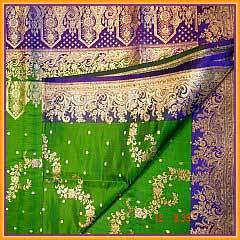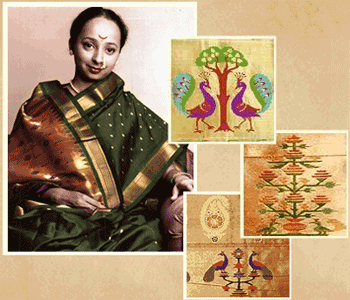
Shantaram’s eyes were weary. But he couldn't’t suppress the proud smile on his face. A masterpiece all the way, he thought to himself giving the six-yard wrap one last look. A brush of colour, a touch of tradition and an entire year of laborious craftsmanship... the meticulous weaves had finally taken shape. And it had been worth all the days of working round the clock for Shantaram’s family. After tying the knots on warp and weft threads, dyeing, colouring, weaving and finishing, the beautiful Benarasi Saree was ready. Thus starts an epic novel on the hand loom weavers of the most sought after Saree in the world - The Benarasi..
Often referred to as Benares, Varanasi Varanasi China Banaras is found in the 19th century. With the migration of silk weavers from Gujarat during the famine of 1603, it is likely that silk brocade weaving started in Banaras in the seventeenth century and developed in excellence during the 18th and 19th century. During the Mughal period, around 14th century, weaving of brocades with intricate designs using gold and silver threads became the specialty of Benaras.
organza (Kora)
Georgette sari
Shatir sari.
Traditional designs of the brocade include jasmine (chameli), thousand emeralds (panna hazar), marigolds (gendabuti), betel nut leaves (paan buti), diagonal stripes (tircha) and the corner motif with a mango flower (konia). Originally the saris were embellished with threads made from real gold and silver for use by the royal family. In modern times, this has been replaced by gold- and silver-colored thread, making the saris affordable for the general population.
(paan buti), diagonal stripes (tircha) and the corner motif with a mango flower (konia). Originally the saris were embellished with threads made from real gold and silver for use by the royal family. In modern times, this has been replaced by gold- and silver-colored thread, making the saris affordable for the general population.
 (paan buti), diagonal stripes (tircha) and the corner motif with a mango flower (konia). Originally the saris were embellished with threads made from real gold and silver for use by the royal family. In modern times, this has been replaced by gold- and silver-colored thread, making the saris affordable for the general population.
(paan buti), diagonal stripes (tircha) and the corner motif with a mango flower (konia). Originally the saris were embellished with threads made from real gold and silver for use by the royal family. In modern times, this has been replaced by gold- and silver-colored thread, making the saris affordable for the general population.
Making it affordable for the masses has also led to cheap imitations flooding the market, the power loom capturing the weaver's hand loom, rendering the rich traditional obsolete and endangered.
In a bare village work shed a man sits quietly working on a loom. Look closer and you notice that he is actually sitting in a pit dug into the earthen floor. Hari Ram is middle-aged, non-descript but his fingers weave magic as he works the traditional l pit-loom. A length of pink silk slowly emerges, shimmering with gold threads worked in elaborate mango motifs. He is weaving the traditional Benarasi saree for a bride to wear at her wedding. This silk is the stuff of dreams, of dowries, of rituals and sacred traditions. today thousands of Benaras weavers like Ram have little work and it fetches a pittance. Kumaoli village, where Ram lives, once had 70 looms. Today, there are four left. In dozens of villages around the holy city hand looms lie dismantled, broken, decaying. The women and men who worked the looms have now been forced into manual work to survive.
Then came the power loom. Many rich traders set up power looms and copied the traditional Benarasi designs. A power loom can churn out in one day a saree that may take a weaver 10 days to make on a hand loom. Power loom sarees are light weight and cheaper and most customers cannot tell the difference between power loom and hand loom fabric.

A dying art, an incomplete trousseau! There are organizations in support of this art, a movement that has started to protect and cultivate this rich heritage of India. This is a tribute to the craftsman, to the wonder of an age old tradition, to a movement that is forming to bring back a dying art. Let's not blindly buy imitations when the originals are not only priceless for our wardrobes but also ensuring that a weaver's family gets his due!!
| The current scernario has the Human Welfare Association (HWA) demanding a separate ministry for the handloom sector. Arguing for the aggressive promotion of the Handloom Cluster Development and Handloom Mark and Silkmark schemes as well as Geographical Indicator protection for Benaras handlooms. HWA has organised public protest by weavers, burning Chinese silk and demanding a ban on dumping. HWA also started the Taana Baana cooperative which provides livelihood to over a thousand weaver families, helping them with credit, design development and marketing support, as well as alternative income generating opportunities. It has a small retail outlet in Sarnath and a turnover of Rs. 70 lakh. But, given the scale of distress among the weavers, Taana Baana is at best a demonstration of what needs to be done for the industry as a whole. |

Posted by Sujata













 There are also several references to the fact that in Southern part of India the sari had been for a long time one piece of material that served as both skirt and veil, leaving the bosom bare.
There are also several references to the fact that in Southern part of India the sari had been for a long time one piece of material that served as both skirt and veil, leaving the bosom bare. In North Indian miniature paintings, (particularly Jain, Rajasthani and Pahari schools from the 13th to the 19th centuries) the sari consisted of the diaphanous skirt and an equally diaphanous veil draped over a tiny bodice.
In North Indian miniature paintings, (particularly Jain, Rajasthani and Pahari schools from the 13th to the 19th centuries) the sari consisted of the diaphanous skirt and an equally diaphanous veil draped over a tiny bodice.

 In the following posts on this page we shall continue to bring forth the various weaves, textiles and drape forms of the saree as is worn in the different parts of our country.
In the following posts on this page we shall continue to bring forth the various weaves, textiles and drape forms of the saree as is worn in the different parts of our country.



